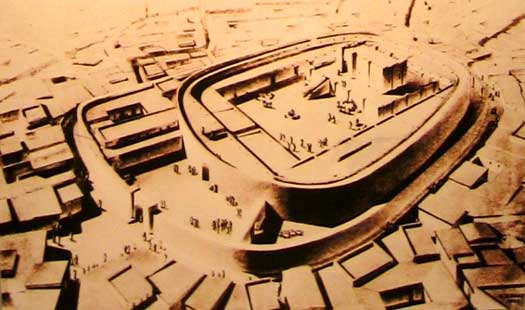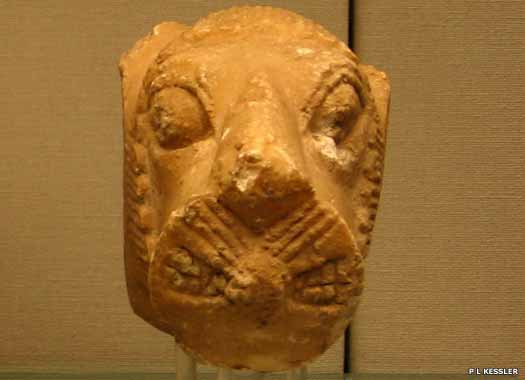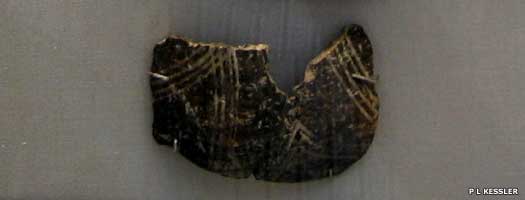|
|
Middle East Kingdoms
Ancient Mesopotamia
|
|
|
|
  Sumer (Ki-en-gir)
 Sumer was one of the first great civilisations, emerging slightly ahead of that of Ancient Egypt and up to a millennium before that of the Indus Valley culture. Located in southern Mesopotamia (modern Iraq), by the late fourth millennium BC Sumer (or Ki-en-gir, 'Land of the Sumerian tongue'), was divided into approximately a dozen city states which were independent of one another and which used local canals and boundary stones to mark their borders.
Many early events are found only in the Sumerian king list, which lists the rulers of the Mesopotamian city states, and one which was updated until about two centuries after the fall of Sumer. Ranging from legendary early names (backed in lilac and which may still have a basis in historical fact), to the later fully-historical dynasties which are confirmed by archaeology, the list records many names and lengths of rule (exceptionally long where the legendary rulers are concerned), but omits others. It also lists some contemporaneous dynasties as if they followed each other, suggesting that the kingship which was handed down by the gods could only be passed to another city through military conquest.
 There are at least four different translations which sometimes agree and sometimes disagree on the names of rulers and their (legendary) lengths of rule. Here, for kings listed after the flood, List 1 (Samuel Kramer) is primarily used. For the most part, List 2 (JA Black, et al) and List 4 (LC Gerts) seem to agree with one another, so the latter is omitted here. Where List 2 and List 3 (Michael) provide a noticeably different translation from List 1, the data is shown here in the respective text colours. List 1 is used exclusively for pre-Flood kings. Some additional data comes from the WB-62 translation of the list.
The Sumerian lugals (or kings, a title which long outlived the Sumerians themselves) exercised power in eleven cities in southern Mesopotamia (according to the Sumerian king list). This amounted to a total of 134 kings (MS P4+Ha has 139), who altogether ruled for 28,876 + X years (MS P4+Ha has 3,443 + X years). While the lengths of rule for the semi-legendary kings are calculated on a scale which makes them appear fanciful, the names themselves probably reflect real rulers.
|
| | |
Kings Before the Flood
The Sumerians were a non-Semitic people who may have moved southwards into Mesopotamia in the mid-fifth millennium BC, although archaeological evidence suggests a cultural continuity that originates them in central Mesopotamia. From there they drifted into the south and gradually started to develop the area. The earliest document describing that Sumerian invention, the wheel, dates to circa 3500 BC.
The king list states that eight kings in five cities ruled for 241,200 years before the Flood swept over the land. Their reigns are measured in sars - periods of 3600 years - and in ners - units of 600, and one suggestion is that these should be converted into years and months (those calculations are shown in the list in brackets).
|
|
The Sumerian city states rise to power during the prehistoric Ubaid and Uruk periods (5300-2900 BC), but the historical record only begins to emerge with the Early Dynastic period from circa 2900-2334 BC, although it remains rather thin until the Lagash Dynasty period begins in circa 2550 BC.
The early city states of Sumer in order of ascendance are as follows: Eridu, Bad-Tibira, Larak, Sippar, Shuruppak, and Nippur (usually without a kingship of its own). Other ante-diluvian cities exist, but without any known kingships of their own. Instead these flourish later.
 |
| Reconstruction of a Sumerian temple |
|
|
| | |
City State of Eridu / Eridug
Situated seven miles south-west of the later city of Ur, Eridu was said to be one of the five cities built before the Flood. According to Sumerian mythology, Eridu was founded by the Sumerian deity named Enki, later known by the Akkadians as Ea, god of water and wisdom. It seems to have made the step up from being a village in around 4000 BC, after about a thousand years of local habitation. By the time of its kings (roughly 3000-2900 BC) it had grown into a substantial city of mud brick and reed houses. It was also home to the oldest known temples, dating from the mid-sixth millennium.
According to the king list, Eridu was host to the First Kingship (of Sumer, before the Flood). 'When kingship was first handed down from Heaven, the city of Eridu was chosen as the seat of kingship.' A total of two kings ruled for 64,800 years, once (one dynasty) in Eridu and then the kingship was removed to Bad-tibira. |
|
Alulim
|
Ruled for 28,800 years (8 years?).
|
|
Alalgar
|
Ruled for 36,000 years (10 years?).
|
| | |
c.2045 BC
|
By this point, perhaps a millennium after hosting the kingship, the city has declined, although Amar-Sin of Urattempts to rebuild the ziggurat. Eridu is abandoned during his reign as salinity problems have made agricultural pursuits in this region unprofitable. There is little evidence of occupation after this date. |
| | |
| | |
City State of Bad-tibira
Second of the pre-Flood city states, Bad-Tibira (with a probable modern location at Tell al-Madain) was situated on the Iturungal Canal, below Umma. The Bible mentions it as Tubal. The city's main god was Lulal, while the city's temple was E-mush-kalamma, which was mentioned in the tale, Inanna's Descent to the Underworld. Bad-Tibira seems to have greatly lost its importance after the Flood, although it was known by the Greeks as Panti-Biblos.
According to the Sumerian king list, a total of three kings ruled for 108,000 years, once (one dynasty) in Bad-tibira and then the kingship was removed to Larak. A later version of the list written in Larsa in the Gutian or Third Dynasty of Ur period, inserts Kichu-Ana as the second king in the sequence. Perhaps this king had been omitted from other lists for political reasons. |
|
Enmenluanna / (En-Men-Lu-Ana)
|
Ruled for 43,200 years (12 years?). Founded the city.
|
|
(En-Men-Ana / Kichu-Ana of Larsa) |
(From the WB-62 list. Some versions swap him for Kichu-Ana.)
|
|
Enmengalanna / (En-Men-Gal-Ana)
|
Ruled for 28,800 years (8 years?).
|
|
Dumuzi (the Shepherd)
|
Ruled for 36,000 years (10 years?).
|
| | |
| | |
City State of Larak / Larag
The location of Larak has not been identified, but it is believed that the city was on the west bank of the Tigris to the east of Kish. Its patron deity was Pabilsag, god of the trees.
According to the Sumerian king list, one king ruled for 28,000 years, once (one dynasty) in Larak and then the kingship was removed to Sippar. |
|
Ensipazianna / (En-Sipad-Zid-Ana)
|
Ruled for 28,000 years (8 years?).
|
| | |
| | |
City State of Sippar / Zimbir
Evidence shows that Sippar was occupied from the Uruk Period (3900-2900 BC), although there were actually two cities named Sippar. This one (modern Tell Abu Habbah) was a dual city, half of which was under the protection of the sun-god Utu of Sippar (Shamash in Akkadian), and half under the goddess, Anunit. Sippar is known as Sepharvaim in the Old Testament, which alludes to the city in its dual form. Another Sippar was probably situated to the north, close to or part of early Agade.
According to the Sumerian king list, one king ruled for 21,000 years, once (one dynasty) in Sippar and then Sippar was abandoned and the kingship was removed to Shuruppak. |
fl c. 2820 BC
|
Enmeduranna / (En-Men-Dur-Ana)
|
Ruled for 21,000 years (5.8 years?).
|
| | |
fl c.1900? BC
|
A short dynasty of Amorite rulers appears to gain control in Sippar.
 |
| Gypsum lion head finial, possibly from the throne of a votive statue of Early Dynastic III at Sippar, about 2500 BC. The Sumerian word for 'king' is inscribed on one side |
|
|
|
Altinu'u
|
Possibly seized the throne.
|
|
Bunu-tahtun-ila
| |
|
Immerum
| |
|
Sin-bani
| |
by c.1792 BC
|
The city has been conquered by the early kings of Babylon. |
| | |
1174 BC
|
Kutir-Nahhunte III, king of Elam and conqueror of Babylon, sacks the city. |
| | |
481 BC
|
A revolt against the Achaemenid Persian king, Xerxes, is put down. All activities in the Sippar temple seem to cease after this date. |
| | |
| | |
City State of Shuruppak / Curuppag
Shuruppak began life near the beginning of the Jemdet Nasr Period (3100-2900 BC), which ended with the Flood. The city was located at modern Tell Fa'rah, situated to the south of Nippur on the banks of the Euphrates. It was also known as Curuppag ('the healing place'). Dedicated to Sud (who was also called Ninlil), the goddess of grain and the air, it became a grain storage and distribution city, with more silos than any other Sumerian city.
According to the Sumerian king list, one king ruled for 18,600 years, once (one dynasty) in Shuruppak and then the Flood came.
|
fl c. 2810 BC
|
Ubartutu / (Su-Kur-Lam?)
|
Ruled for 18,600 years (5.17 years?) / (8 years, from WB-62 list.)
|
fl c. 2800 BC
|
(Ziusudra / Zin-Suddu)
|
(Son of Su-Kur-Lam. On the WB-62 list: 10 years).
|
c.2800 BC
|
 The Flood ends the ante-diluvian Jemdet Nasr Period in Sumer.
|
| | |
c.2000 BC
|
Probably part of the holdings of Ur until its collapse, by this point the city has already been abandoned. |
| | |
| | |
Kings After the Flood
The Sumerian myth of Ziusudra exists in a single copy, the fragmentary Eridu Genesis, which is datable by its script to the seventeenth century BC (a version of which was later adapted in Babylon, and then in the Old Testament, compiled in the sixth century BC). It tells how the god Enki warns Ziusudra, king (or prince, or noble) of Shuruppak, of the gods' decision to destroy mankind in a flood (the passage describing why the gods have decided to do this has been lost). Enki instructs Ziusudra to build a large boat (the instructions for which were also thought lost until the chance discovery of a tablet that revealed them. Dated to around 2000 BC and translated in 2013, it laid out instructions for a massive, round, coracle-like boat). After a flood of seven days, Ziusudra makes appropriate sacrifices and prostrations to An (the sky-god) and Enlil (chief of the gods), and is given eternal life in Dilmun (the Sumerian Eden) by Anu and Enlil.
The Sumerian king list also mentions a great flood, and excavations in Iraq have shown evidence of a flood which left deposits at Shuruppak, Uruk and Kish somewhere between 2900-2750 BC. The king of Kish, Etana, supposedly founded the first post-diluvian Sumerian dynasty: 'after the Flood, the kingship was handed down from Heaven a second time, this time to the city of Kish which became the seat of kingship.' The flood might have been no worse than that experienced in south-western England during summer 2007, but to a purely agrarian society it might have seemed like the end of the world. |
|
The kingship is given for a second time to Kish, and then it passes onto a succession of city states who each claim it in turn, according to the king list.
Sumerians continue to control southern Mesopotamia. The major city states are: Adab, Agade (Akkad), Bad-Tibira, Borsippa, Eridu, Girsu, Isin, Kish, Lagash, Larsa, Mari, Nippur, Shuruppak, Ur, and Uruk (Eanna).
The minor city states are: Akshak, Awan, Dilbat, Eshnunna, Hamazi, Kisiga, Kisurra, Kutha, Larak, Marad, Sippar, Umma, Zabala, and Zimbir.
Sumerian domination of southern Mesopotamia comes to the end with the rise of the Akkadian empire in circa2334 BC. Following the Gutian period, there is a brief 'Sumerian renaissance' at Ur in the twenty-second century BC, but this is cut short in circa 2004 BC by an Elamite invasion. The Elamites are pushed out six years later by the Amorites. Their dynasties in Isin and Larsa persist until circa 1763 BC when Mesopotamia is united under the rule of the Amorite Babylonian empire. |
| | |
| | |
Other Mesopotamian Cities
Not all cities in Sumerian Mesopotamia, or further north, were the seats of kings, whether independent or subjects, even though they were well-known and possibly played important roles in Sumerian history. |
| | |
City of Borsippa
 One of the more important cities in Sumer was built on either side of a lake roughly 17.7km (11 miles) south-west of Babylon. Borsippa, (modern Birs Nimrud) is tied in with Nimrod and the Tower of Babel, thanks to its own ancient tower which reached a height of 70m (231ft) when it was new. During the Third Dynasty Period of Ur, Borsippa was usually mentioned in connection with Babylon, being dependent upon it.
|
|
 |
| Early Bronze Age pottery produced in Mesopotamia around 3000 BC |
|
|
| | |
City of Gasur / Nuzi
Gasur was an ancient Mesopotamian city which was located to the south-west of modern Kirkuk in Iraq, near the Tigris (modern Yorghan Tepe). Founded by the Akkadians in the 24th century BC, the site was renamed Nuzi (or Nuzu) when it was occupied by Hurrians after around 2000 BC, and became a prosperous community and important administrative centre. It had its own 'mayor' who was dependent on the Hurrian king of Arrapha. From about 1500 to 1350 BC, Nuzi was on the outskirts of the powerful Hurrian kingdom of Mitanni (still with its own mayor) before it was absorbed into the expanding Assyrian kingdom. |
| | |
City of Girsu
The city of Girsu (modern Telloh) was located approximately 25 km north-west of Lagash. It may have been inhabited during the Ubaid Period (5300-3900 BC), but the main settlement dates to the Early Dynastic IIIb Period (2500-2334 BC). During the reign of Gudea of Lagash, the city formed the capital of the realm, and it continued as Lagash's religious centre after political power had shifted to Lagash. Girsu lost all importance after the Third Dynasty of Ur, but remained inhabited until the 2nd century BC. |
| | |
City of Kutha / Kutu
The minor city of Kutha (modern Tell Ibrahim) was situated on the right bank of the eastern branch of the Upper Euphrates, north of Nippur. Its patron deity was Nergal, the king of the Underworld.
Kutha may be connected to the Cuthah of the Old Testament, in II Kings, and Cuth in II Kings.
|
| | |
City of Uzarlulu
Another minor city was that of Uzarlulu (modern Tell al-Dhiba'i, on the outskirts of Baghdad). It had its own temple, administrative centre, and living quarters, all of which have been unearthed by archaeologists. Hundreds of tablets have been found (including a later mathematical text of the Pythagorus theory). Uzarlulu was also home to probably one of the best examples of a coppersmith workshop.
|
| | |
| | |
| | |
| |
| |
|



No comments:
Post a Comment